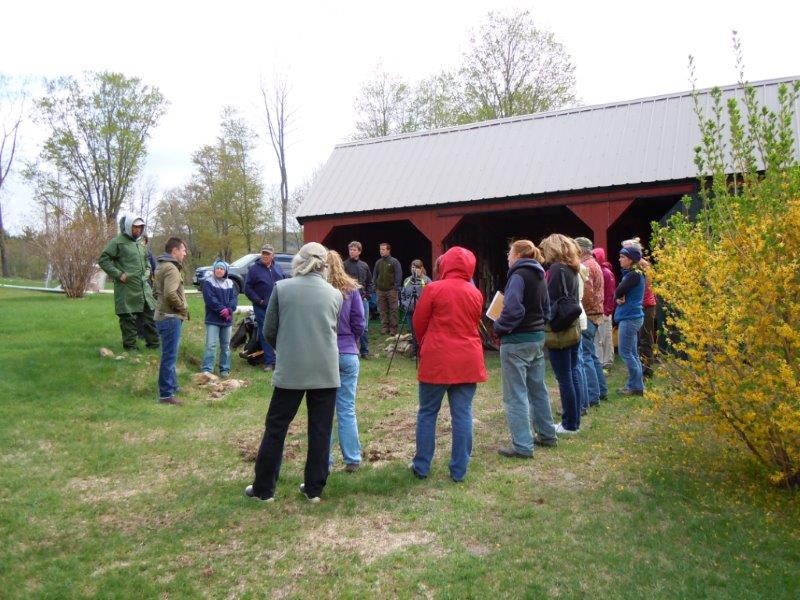
May 14th was a perfect example of why you need to be tough to live in New England. It was 50 degrees outside and overcast with a crisp breeze that made it feel more like 40. New England farmers brave this weather, preparing for the growing season while there’s still snow on the mountaintops. So too native pollinators are diligently working despite New England’s challenging climate. You wouldn’t see honey bees, a Mediterranean species, pollinating in 50-degree weather. Nope, you need a pollinator made of tougher stuff, a pollinator like one of our native bumble bees. As I learned at the Managing Habitat for Pollinators on Farms workshop I attended that chilly day, native bees are perhaps our most important pollinators in cool northern climates. Because of their importance to the stability and sustainability of local farms, there is concern over the decline of native bees and attention being given to aiding in their recovery.
As Eric Mader of the Xerces Society explained, honey bee decline in the United States has received a great deal of press recently. Fewer flowered landscapes, insecticides, parasites, and an aging population of commercial bee keepers have all contributed to a 50% loss in the number of managed honey bee hives within the US since the 1950s. However, the honey bee species itself is not in significant peril. The honey bee is an imported species; although honey bee populations have declined dramatically in the US, it’s numbers are still fairly resilient within its native range. The same cannot be said of native pollinator populations.
There are roughly 50 native bumble bee species in North America well-known to researchers, including the dozen species that call New England home. A quarter of these North American bumble bees are undergoing population declines. In New Hampshire “one of our formerly most common species the rusty-patched bumble bee, Bombus affinis, is on the brink of extinction and very well could disapper from the world this year or next”, Mader warned. Adapted for the cold, wet weather of New England springs, native bumble bees are “disproportionately important as pollinators for crops”, Mader stated, “and to lose them from the landscape around us is an alarming issue.”
Considering the decline of other once-common pollinators, the decline of native pollinators comes as no surprise Mader elaborated. The number of monarch butterflies in North America has declined 90 percent in past 20 years. Similarly, a study by the London Zooligal Society found that, on average, the earth has lost 50% of its wildlife populations in the past 40 years.
Mader’s message, however, was one of hope and empowerment. “We can change the situation very easily” he said, “every single person can do something and make an immediate difference in their local landscape” to restore native pollinators. To do so, organizations including the Xerces Society, New Hampshire NRCS and the NH Association of Conservation Districts are promoting three priorities for bee consevation:
1. Creating diverse pollen and nectar sources throughout the growing season – Bumble bees emerging from hibernation need large quantities of pollen and nectar from spring-clooming flowers. In mid-summer bumble bees are trying to produce new queens. Like bears, these new queen bumble bees hibernate over the winter and therefore need access to late-blooming flowers to build up their fat reserves.
2. Conserving bee nesting habitat – Though we may want to neaten our properties, Mader advocates letting “messy, unkempt” areas that can be found at the edge of farm properties remain. Large bumble bees often nest in abandoned rodent holes. Solitary ground nesters nest in sand and sandy loam and prefer heavy grass or thatched areas which reduced tillage helps maintain. Similarly wood-nesting bees use beetle bore holes in stumps/snags and pithy plants like blackberry canes to nest within.
3. Protection from insecticides – avoiding spraying a crop with a non-systemic insecticide when it’s in full bloom and in the morning-midday when bee activity is highest, for example, allows farmers to manage pests while reducing harm to wild bees Mader explained.
Interested in establishing foraging habitat for native pollinators on your property? Learn more about RMI’s Bee Project!